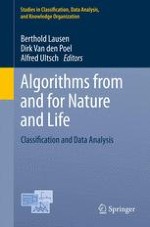2013 | OriginalPaper | Chapter
Clustering Ordinal Data via Latent Variable Models
Authors : Damien McParland, Isobel Claire Gormley
Published in: Algorithms from and for Nature and Life
Publisher: Springer International Publishing
Activate our intelligent search to find suitable subject content or patents.
Select sections of text to find matching patents with Artificial Intelligence. powered by
Select sections of text to find additional relevant content using AI-assisted search. powered by
